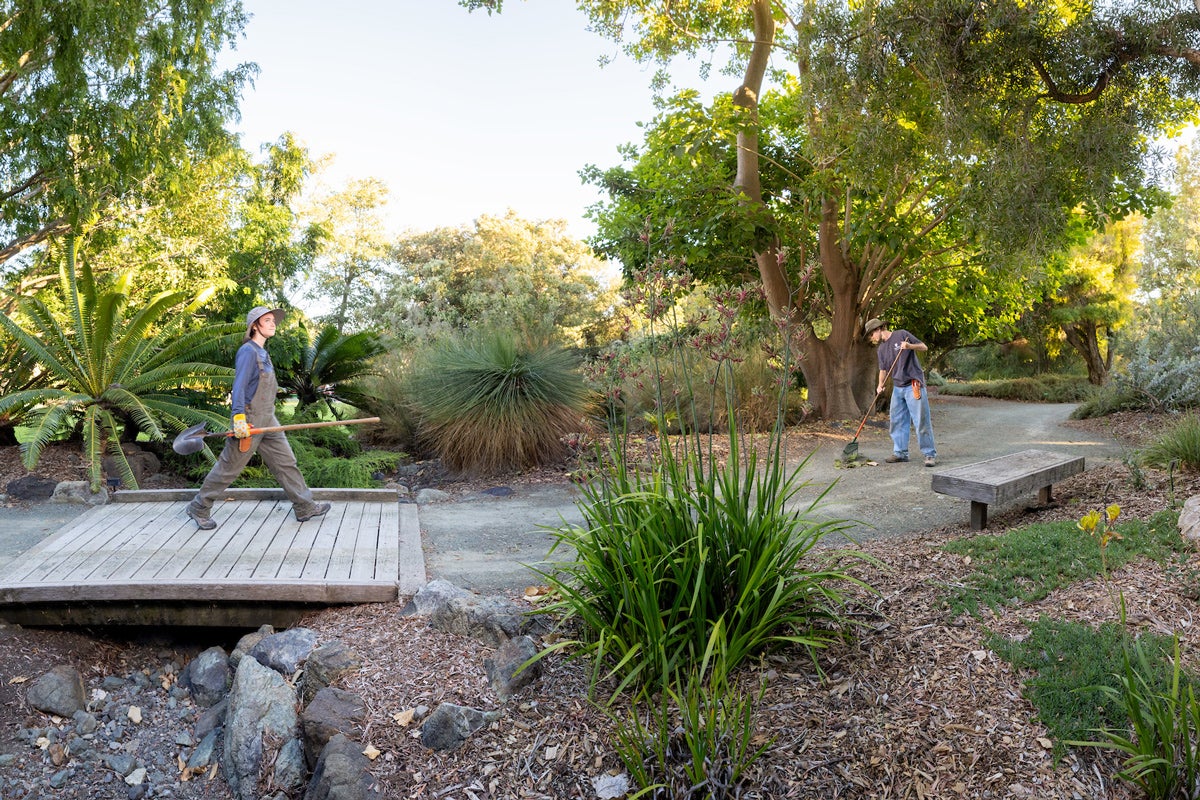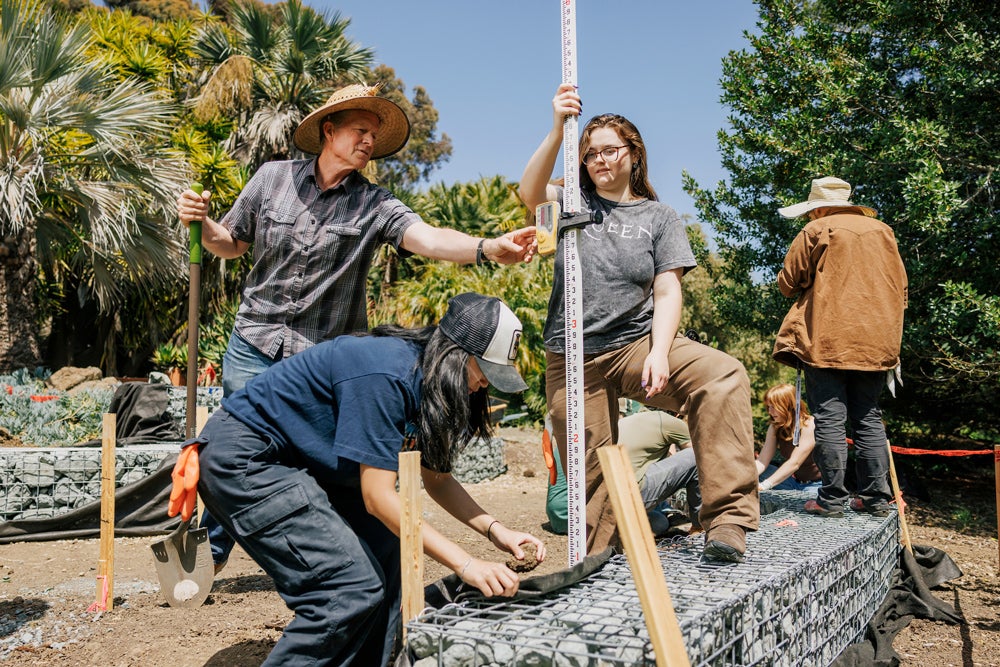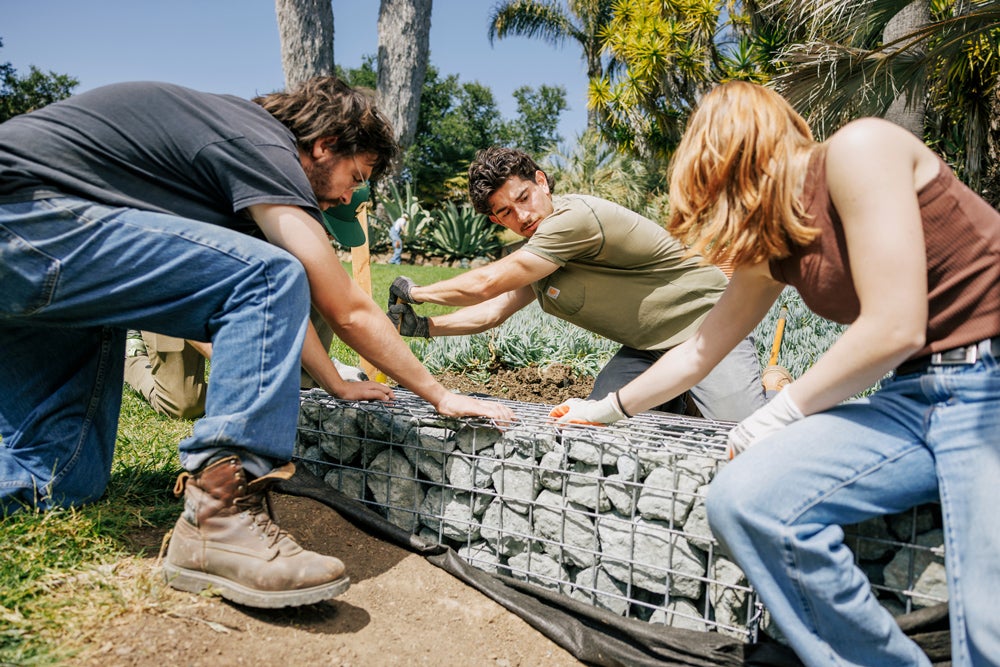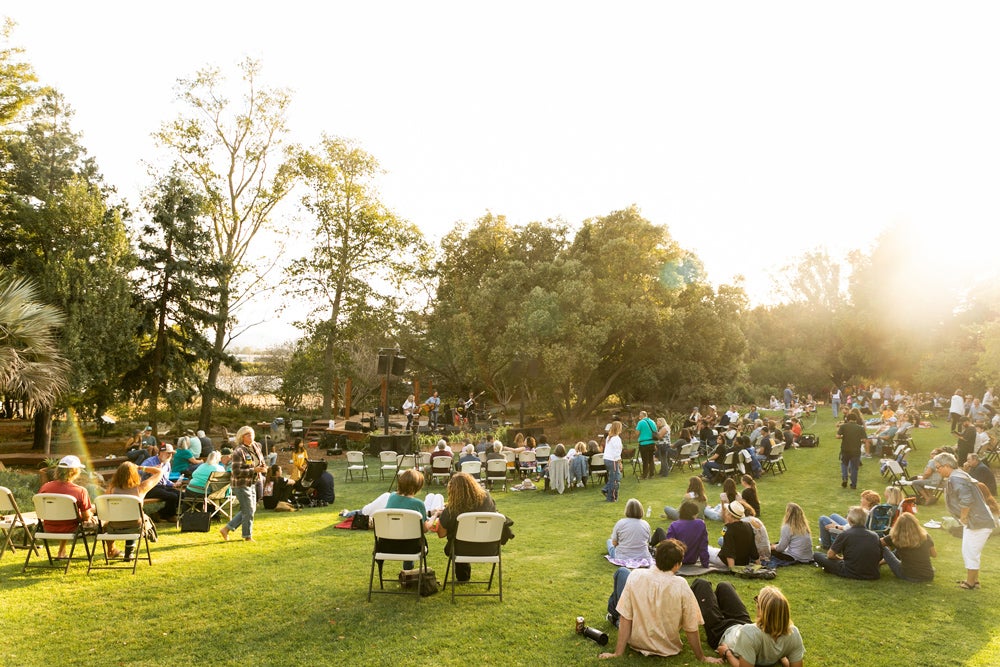Behind the Scenes of Beautification at the Leaning Pine Arboretum

From tending to lush gardens to building accessible seating, students and faculty have been hard at work in Cal Poly’s Leaning Pine Arboretum to prepare the five-acre living laboratory for visitors in the new academic year.
“It’s really a space for everyone,” said Tiffany Faulstich, arboretum manager and Plant Sciences Department lecturer. She oversees a team of student employees who help the gardens thrive year round while guiding large-scale improvement projects. Over the last few months, she has worked with students to lay roughly 500 linear feet of accessible pathways throughout the gardens, creating a more accessible walking loop.
Among them is fourth-year student Wyatt Gouger. Since he joined the crew more than a year ago, he has tended to dozens of species of succulents, managed a special garden of primitive plants and supported the Mediterranean collection with regular watering, weeding, mulching and edging against walking paths.

“It’s given me a lot of different skills,” said Gouger, a plant sciences student concentrating in environmental horticulture. “I learned how to drive the tractor and the skid steer [while] familiarizing myself with all the different tools. I've learned how to properly replant stuff and how to take care of them after they're in the ground.”
Gouger first learned about the arboretum student crew the way many Mustangs do: by taking Faulstich’s AEPS 312: Environmental Horticulture Enterprise Project II, a course that trains students on the basic equipment and practices necessary in tending the arboretum.
Students are primarily responsible for maintaining the heart of the arboretum: a space that showcases plants unique to the world’s five Mediterranean climate regions — Australia, California, South Africa, Chile and the basin surrounding the Mediterranean Sea. Students also keep up a formal garden of neat hedges, a palm and aloe garden with 60 species of succulents and a lush lawn that often hosts small events.
Gouger’s favorite space in the arboretum’s five acres is the Mediterranean collection. “It's shaded, so it feels like a little secret area,” he said. “There are a lot of familiar plants there too — I'm a huge fan of the cork oaks and the olive trees.”
Hannah Kaas, a landscape architecture student and arboretum employee, loves how their work provides a mental break from classrooms and campus noises.
“The garden smells so good — the soil, the plants, the fresh air,” they said. “It gives me a chance to think about things going on in my life or to just tune those thoughts out and get lost in the process.”
Kaas tends to the California collection but loves the vast array of unique plants in the Australian and South African gardens.
“We have a wide variety of plants in the arboretum,” Kaas said, “and it’s great to have the opportunity to apply what I’m learning in my classes to a garden that people at Cal Poly and in the San Luis Obispo community can visit and enjoy.”
When arborists and other professional crews to tackle bigger jobs like tree removal and irrigation, Faulstich says even those projects become learning opportunities for students to understand complementary facets of horticulture.
“I'm a pretty big advocate for this interdisciplinary approach because when you go out and you work in industry you're working with people from all different trades and all different levels of expertise — there's always a learning opportunity,” she said.

Over the last 50 years, Cal Poly’s arboretum has evolved into a collection of class projects, hands-on lab exercises and senior projects guided by the hard work and enthusiasm of students and faculty. But beyond agriculture, many students know the arboretum as a polytechnic playground. It has served as a beloved backdrop for photography classes, biology labs, construction management projects and more over the years.
In spring quarter, a group of landscape architecture students took on a new challenge: building accessible seating next to the lawn using an ancient technique. Students designed, crafted and installed metal cages filled with rocks with bench seats, called gabions. The building method, which comes from the Italian word for “cage,” produced a natural aesthetic that doubled as retaining wall.

The extra seating came in handy when the Leaning Pine Arboretum hosted a celebration in October, gathering the campus and Central Coast communities together to marvel at the decades of hard work that has brought the space to life. Through more public events, Faulstich says she hopes visitors leave inspired by the spectrum of plants from around the world they might enjoy in their own backyards.
“One of the goals of the arboretum is to show the average person what landscapes and projects can look like without using a ton of water,” she said.
Faulstich hopes the experience working and learning in the arboretum will lead to more students studying plant sciences — and filling the vast career opportunities in California and beyond.

“There are real careers in upper-level management for botanical gardens, arboretums, parks, public gardens, corporate campuses and more,” she said. “These students go on to make a good living and become regional managers, park superintendents or golf course superintendents. There are six-figure incomes to be had for these students if they stick with it and rise through the ranks.”
“I feel really good after every single day working here,” Gouger said. “It’s definitely shaped what I want to do outside of college, and it’s given me a lot of different skills. I’m excited to come back in 15 or 20 years and see what I planted grow.”
Visitors can explore the arboretum five days a week from 8:30 a.m. to 5, Monday through Friday. For more information, visit the Leaning Pine Arboretum website.
Want more Learn by Doing stories in your life? Sign up for our monthly newsletter, the Cal Poly News Recap!




